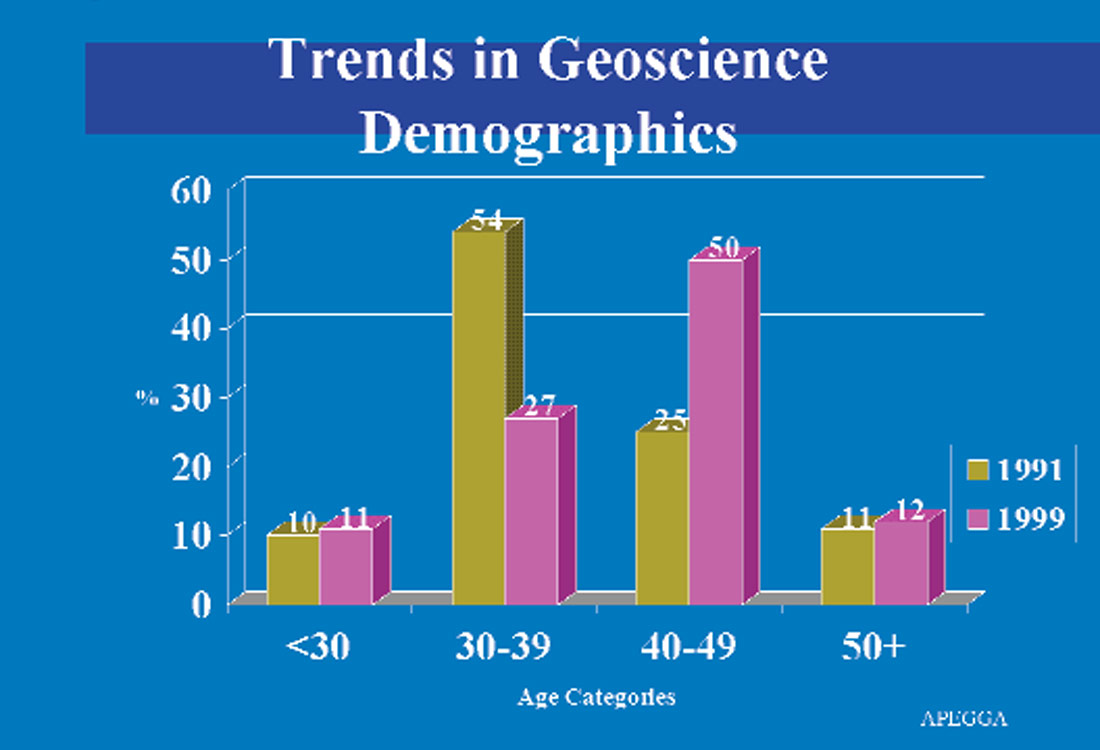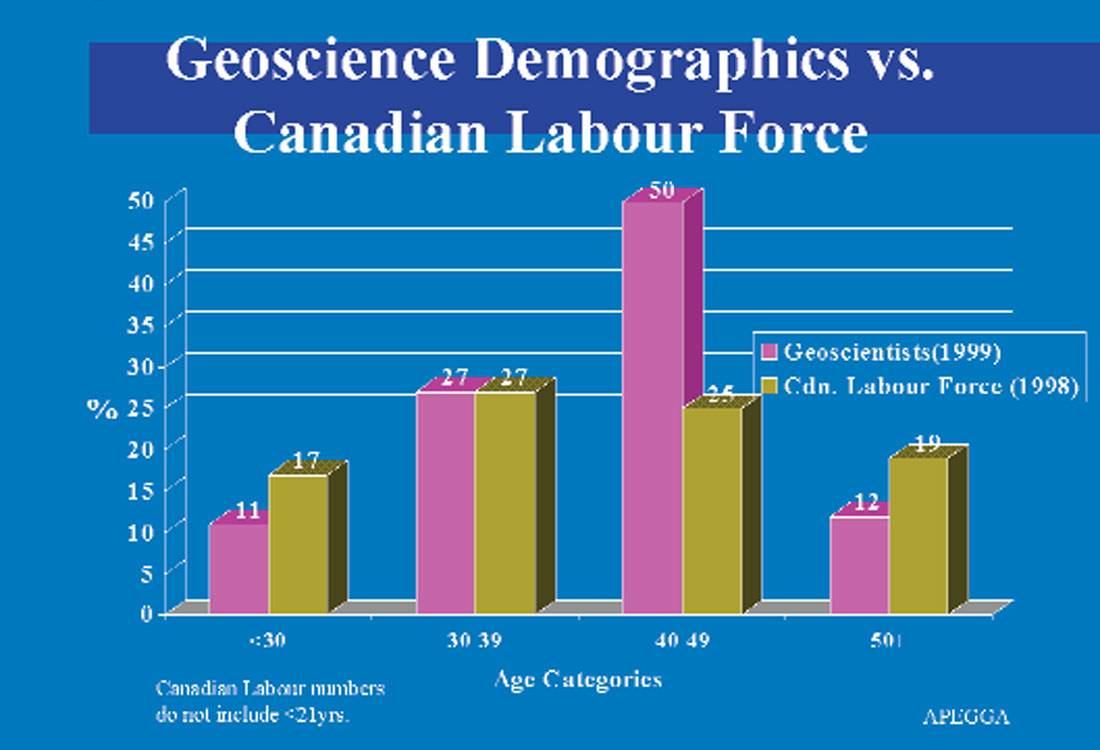For the last two years, a Geoscience Task Force struck by APEGGA Council has sought ways to make geologists and geophysicists feel they are more a part of the Association. The current Task Force Chair, Elaine Honsberger, P.Geoph., recently shared some thoughts on what has been accomplished and on what remains to be done.
APEGGA Council’s Geoscience Task Force has completed its task. Yet the work needed to make geoscientists feel completely at home and comfortable within APEGGA must continue, suggests Elaine Honsberger, P.Geoph. The APEGGA Councillor is the current task force chair and one of its members since it was set up in the spring of 1998 to recommend ways of improving relationships between APEGGA and geoscientists practicing geology and geophysics in Alberta.
Toward that end, Ms. Honsberger, and others who also have served on the task force during the past two-years — Neil O’Donnell, P.Eng., P.Geol., Alice Payne, P.Geol., Brenda Wright, P. Geol., Gordon Williams, P. Geol. and John Boyd, P.Geoph., along with staff representatives Al Schuld, P.Eng., and Marie Locke — have devoted considerable time and energy to the task force. In reporting to the June APEGGA Council meeting, the task force recommended its own demise and that implementation of its recommendations proceed via a permanent mechanism — possibly a standing committee. (Council tabled the recommendations for further consideration at its September meeting.)
Ms. Honsberger, a senior geophysicist with Alberta Energy Company, noted some geoscientists have questioned their place within APEGGA, 86 per cent of whose professional members are engineers. Furthermore, some geologists and geophysicists don’t like having to register with APEGGA to practice their professions. While it was known that not all geoscientists practicing in Alberta belonged to APEGGA, the numbers had never been well quantified.
Demographic Data
“One of our terms of reference was to measure the size of the problem,” says Ms. Honsberger, noting that the task force set out to do just that by commissioning an outside report by KPMG Consulting. Completed in the spring of 1999 and based on a random selection of Alberta organizations employing geoscientists, the report provided some interesting demographic breakdowns. Of the 683 persons with geoscience degrees captured by the sample, 59 per cent (59.1 for geologists and 58.8 for geophysics) belonged to APEGGA. Breakdowns showed that APEGGA participation rates were higher (66 per cent ) among medium-sized companies (employing 10 to 30 geoscientists) and lowest (54 per cent ) among employers with more than 30 geoscientists on staff.
Based on the sample size of the survey and the method of data acquisition, KPMG felt these numbers are highly correlatable to the population of all geoscientists practicing in Alberta. This implies that 41% of Alberta’s geoscience practitioners are not members of APEGGA.



Middle Age “Bulge”
The KPMG survey also provided interesting data showing 50 per cent of the sampled geoscientists were aged 40-to-50 years, 27 per cent were 30-39; and 11 and 12 per cent respectively were under 30 and over 50. The demographics of the geoscience population turned out to be very similar to those of the Canadian workforce, with the exception of the rather large spike in the 40-50 year category - something for employers to contemplate in the years to come as this age group starts to wind down its efforts in the workforce.
The breakdown of membership relative to age showed the demographics of the non-member and member groups were essentially the same as the overall demographic breakdown of the entire population. In other words, 50% of non-members are in the 40-50 year category.
Qualitative Information
Armed with this quantitative data, the task force sought some qualitative and anecdotal information about how geoscientists relate to APEGGA. Gathering venues for such information included “brown bag” lunches to which geoscientists were invited, as well as sessions with some Permit holders to seek their input.
According to Ms. Honsberger, the sessions not only provided feedback on feelings, pro and con, for joining APEGGA. Comments also showed the degree of support for APEGGA and for professional registration — among members and non-members — varied widely. Geoscientists registered with APEGGA included those who not only support licensing but who demonstrate that by devoting time to the Association. The membership also contains reluctant registrants who do so merely to satisfy a legal requirement.
Interestingly, not all non-members reject the value of registration. As one might expect, non-registrants also included some who questioned or totally opposed registration.
“Most geoscientists I have spoken to aren’t particularly happy, historically, with how they’ve been integrated into APEGGA,” Ms. Honsberger explained.
“I can see the problem that APEGGA has. It is not an optional one. We were put in place through legislation from the Alberta government to regulate these three professions and we’re not necessarily mandated to sell the value of registration; but in order to get people to buy into it, we do need to sell it.”
This selling job, she suggested, must occur both inside and outside APEGGA.
An important task force recommendation centres on improving the effectiveness and style of communication with geoscientists (including students). This, the task force suggests, can occur through The PEGG; via publications or events specifically geared for geoscientists — including those sponsored by technical societies such as the Canadian Society of Petroleum Geologists and the Canadian Society of Exploration Geophysicists.
Besides getting earth scientists to move toward APEGGA, the task force also suggests there may be some ways for APEGGA to become more accommodating by moving toward geoscientists.
As noted in the KPMG report, more than a third of geoscientists working in Alberta are not APEGGA members. Ms. Honsberger notes that, particularly in the late 1970s and early 1980s, the perception may have emerged of trying to fit “round” geoscientists into “square” regulatory “holes” which may have been designed mostly with engineers in mind. Two decades ago, Alberta experienced a surge in hiring of geoscientists (many now in the 40-to-50 demographic bulge). Among them were geologists and geophysicists with Canadian or international training who applied to register with APEGGA. However, the academic requirements for licensing resulted in the applicants being assigned exams by the Board of Examiners. Some perceived this as a slight against their training. Furthermore, Ms. Honsberger suggested, the Board of Examiners of the day may not have offered applicants much latitude to demonstrate how their practical experience offset supposed academic shortcomings. Faced with such deflection or rejection, some applicants simply never made another attempt to register.
Transitional Period Suggested
To rekindle interest, the Geoscience Task Force has suggested a “transitional period “ — a form of grandparenting to allow APEGGA registration by those having a degree, 15-plus years of geoscience employment experience, and four references. It would be the Board of Examiners prerogative to adopt such a policy but, in Ms. Honsberger’s view it “would open up the opportunity for people who have possibly close to 20 years experience to enter the organization. They already are practicing, they have many years of experience to show whether they are competent. It’s incorporating some people who got left behind.”
Where the Task Force goes from here will be determined within the next few months. Ms. Honsberger’s view is that APEGGA has its work cut out to bring on board the estimated 41% of the geoscience practitioners who are not registered with APEGGA. The Task Force’s goal for APEGGA is that, in time, with strong communication links and a supportive, open attitude - our association will see those numbers improve for the betterment of all Albertans.
Professional Licensing & Code Carry Ethics Beyond Personal Standards
As an active volunteer in the Canadian Society of Exploration Geophysicists (CSEG) and APEGGA, Elaine Honsberger, P.Geoph., considers the two organizations to have critical, but distinct, roles.
The APEGGA Councillor believes CSEG as a technical society is geared toward improving and building members’ technical skills. APEGGA’s core mandate is to serve society and protect of the public by regulating the professions.
In the case of a geoscientist, the risk posed to public wellbeing may seem less immediate than in the case of negligence by an engineer designing a bridge.
However, geoscientists’ work also affects the public safety — for instance, in avoiding and mitigating environmental degradation. Also important is ensuring that public welfare — including that of shareholders — is not imperiled through shoddy work or unethical conduct when appraising or evaluating companies’ assets or prospects.
“As geoscientists we are involved in the presentation of data, and the reviewing of data, including quick assessments, on the value of companies,” Elaine Honsberger notes.
She is confident most geoscientists act ethically, even when they are not meeting the legal requirement of belonging to APEGGA. But she sees added value in belonging to an organization with a legislated Code of Ethics, something grounded in more than one individual’s personal values.
“APEGGA gives me a Code of Ethics which I have agreed to follow. That’s valuable to me if I come into a situation where I or someone else is asked to do something which I perceive to be unethical. It is one thing to say ‘Elaine Honsberger’s ethics don’t allow that’. That really doesn’t matter. It’s a different thing for me to say ‘I’m a member of a professional organization and the activities you are suggesting my colleagues or I conduct are unethical according to our professional association.’ It’s quite defendable and that’s very helpful.”
She adds: “Being a professional member is not going to stop all unethical conduct in Alberta. While most of us are law-abiding citizens, if we’re in a situation where we know that our actions could come under scrutiny and our livelihood could be at stake, we might reconsider some of our actions. For me it should be reassuring to others knowing I’ve promised to live up to the standards.”
Beyond providing a standard for personal behaviour, APEGGA also should be where geoscientists turn once they see others acting unethically.
“I think we, as geoscientists, should be using APEGGA more to follow up and to question how we conduct ourselves. We have to use the processes more if we want to see what APEGGA’s influence can be. We should use the Association for what it’s there for. I don’t think we are doing that enough.”

Acknowledgements
This article is reprinted courtesy of APEGGA. It was originally featured in the September 2000 PEGG.










Join the Conversation
Interested in starting, or contributing to a conversation about an article or issue of the RECORDER? Join our CSEG LinkedIn Group.
Share This Article